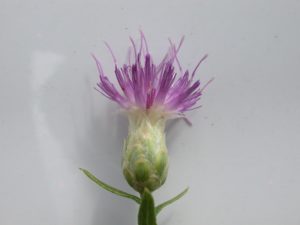Aulacidea acroptolonica
- Common Name: Russian knapweed gall wasp
- Insect: Gall wasp
- Generations Per Year: One
- Overwintering Stage: Larvae (galls in stems)
BIOLOGY: Gall wasps are small and black. They do not have stingers. Adults emerge in early spring around April – May. They lay eggs in stems. Microscopic larvae hatch in stems to form hard, pea-pod shaped galls. Larvae overwinter inside stems.
DESTRUCTIVE STAGE: Larvae (galls in stems)
IMPACT TO HOST: Gall formation can impact plants by reducing resources to kill plants. It is still too early to determine overall impact to Russian knapweed. However, early results show high establishment and distribution rates of insects.
REDISTRIBUTION: Collect dry galls infested with larvae in early spring. Hatch gall wasps in lab or quarantine and collect adult wasps for redistribution into the field.


